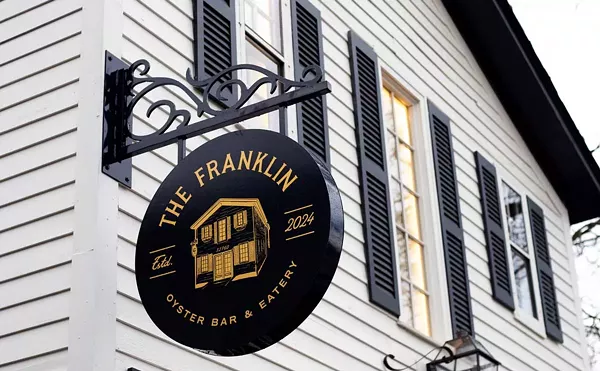
Audio By Carbonatix
[
{
"name": "GPT - Leaderboard - Inline - Content",
"component": "35519556",
"insertPoint": "5th",
"startingPoint": "3",
"requiredCountToDisplay": "3",
"maxInsertions": 100,
"adList": [
{
"adPreset": "LeaderboardInline"
}
]
}
]
OODLES OF STRUDELS
Unless you’ve been to Allen Park’s Hungarian Strudel Shop – or have an industrious Eastern European grandmother – you may never have eaten hand-pulled strudel.
"The thinner the flakier" is Helen Blessing’s motto, so she and her brother John Arnoczki, who emigrated from Hungary as children in 1956, spend hours stretching a simple dough to produce translucent sheets of pastry.
Arnoczki is dismissive of commercial strudel. "You can see the shortening oozing out of it," he says. "It’s like pie crust."
Lots of people like pie crust just fine, but if you’ve ever been frustrated in your pie-baking attempts because the dough tears when you roll it, you will appreciate Blessing and Arnoczki’s efforts all the more.
Starting with a 10-pound lump of dough – water, high-gluten flour, shortening and a bit of egg – they expertly caress and pull the mixture till it’s 12 feet wide by 25 feet long. You can see through it.
It works like this: First the dough goes through a small machine called a sheeter for some initial stretching. Blessing says the dough reacts differently every day, depending on the humidity and temperature, so she adds flour and adjusts her stretching technique accordingly.
Today the dough is very elastic, springing back like a rubber band, perhaps because of the cold. She casually manhandles the sheet onto a giant table, almost 20 feet by 5 feet. Then, quickly and gently, the two tug and pull from the edges. The dough turns into a huge billowing sheet; wave after diaphanous wave ripples down the table. Who would have thought pastry could be beautifully eerie?
Arnoczki then sprinkles a little melted shortening from a big brush, using a practiced sideways motion. "I can give a bishop a run for blessings," he says.
Helen Blessing flings a very scant layer of bread crumbs and sugar over all. This is necessary, she explains, to keep the layers apart. Otherwise, they’d stick together into one layer, and "what’s the point of all this work – it would be like pie dough."
When the sheet is stretched almost to the floor, the next step is to open the specially hinged leaves of the custom-made strudel table, to stretch the dough even more.
Another layer of crumbs and sugar, and then the leaves are folded the other way, back down to the tabletop, to double the dough back on itself. That’s two layers. The third is created by cutting pieces off the end flaps and piecing them on, like a quilt. Finally the filling is applied, with a fruit-caulking gun, and the dough is rolled seven times, from each side toward the middle. That’s how you get 21 layers of flaky strudel around your apples, cheese or cherries. Those are customers’ favorite flavors; they can also get walnut, apricot or blueberry, or mix cheese with pineapple, blueberry or strawberry. At $4.50-$5 for this labor of love, it’s a steal. And that’s the 10-inch baked version; the 20-inch bake-it-yourself is only $7.25.
Arnoczki and Blessing have run the Hungarian Strudel Shop for 22 years. One customer says it’s an Allen Park institution. "I’d cry if they weren’t here anymore," she tells me. "I might lose weight, but I would cry."
The Hungarian Strudel Shop is at 6816 Park Ave., Allen Park, 313-383-3440.
TREATS
Fishbone’s Rhythm Kitchen Café (400 Monroe St., Detroit) hosts a Mardi Gras costume party and N’Awlins-style buffet on Tuesday, March 7. Tickets are $20, call 313-965-4600 for more info. ... Applaud Ann Arbor’s University Musical Society, whose cookbook, Bravo!, won second place in the national Tabasco Community Cookbook contest. Proceeds from this collection support music education and the performing arts. To order yours, send $29.95 plus $5 shipping and handling to University Musical Society, 881 North University Ave., Ann Arbor, MI 48109-1011.






